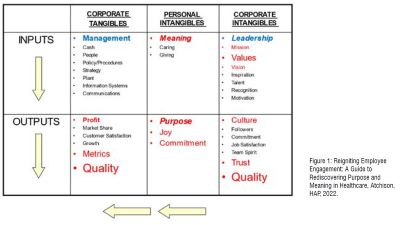Talent management is a critical strategic challenge throughout healthcare today. Prior to 2020, there was a serious problem with shortages of physicians, nurses, and other care givers. The Covid pandemic moved this serious problem to a crisis level. Burn-out, quiet quitting and early retirement are some of the residual post-Covid phenomena. Most healthcare delivery systems have a need to identify, recruit, select and retain the most qualified professionals to serve their community. This very critical need to recruit and retain the best professionals is further hampered by another post-Covid factor of weak financials. Given these contemporary realities, this article will present some practical ways to recruit and retain high performers. The main thread throughout this discussion of the recruitment and retention is “Values Alignment.” Sustainable high performance is a function of the individual workers’ core values being aligned with the healthcare delivery system’s core values, which is often described as the organization’s Corporate Culture.

Organizations are comprised of two very different, yet interdependent variables: tangibles and intangibles. Tangibles are those elements that can be observed and measured using standard quantitative techniques. Financials, productivity, quality outcomes, clinical processes are some of the more obvious tangibles. Employee engagement, trust, respect, pride, and perceived fairness are common intangibles. The most successful corporations use the corporate tangibles, personal intangibles and the corporate intangibles when designing the competencies needed for a job position. Less successful companies focus mainly on tangibles such as academic credentials, history of employment, and salary requirements. Figure 1 shows the tangibles and intangibles which need to be considered in all recruitment, selection, and retention strategies.
The most successful recruitment, selection and retention systems blend the tangibles and intangibles in all aspects—talent identification, selection, on-boarding, professional development, rewards, recognition, and, if necessary, de-selection.
The first step in creating a successful recruitment process is to identify the job competencies. This list of competencies must include the technical (tangible) and the attitudinal (intangible) requirements for the job. The best way to decern the necessary competencies is by using “Trait Analysis.” Start with a blank poster board sheet and draw a line down the middle. On one side list the knowledge and skills a person must possess to be successful. And, on the other side, list the personal and attitudinal requirements the individual must display to fit into the corporate culture.
Once the two lists are created, then it is necessary to rank the items from “absolute requirements” to “nice to have requirements”. This list should be used to draft “Help Wanted Ads” and to be used as a template for the interview and selection process. Too often individuals are hired for their technical expertise and then later fired for their lack of the necessary personal and attitudinal traits.
Assuming the recruitment process has been successful and provided several candidates who possess the technical and personal traits to be successful, the task now is to select the “Best” among the “Good”. The job interview process must be designed to select the best candidate. One or both of two interview techniques need to be used. These techniques are “Value-based Interviews” and “Targeted Selection”. A detailed description of these techniques is beyond the scope of this article. However, a simple Google search will yield several good ideas on both techniques. The more successful interview processes include a team approach using the staff with whom the new hire will be working. The team, using the techniques mentioned above, can come to a consensus on the best person to hire.
The recruitment and selection process has been successful and now the new hire must learn about the organization into which they have joined. Historically, new employee orientation has been a one-time presentation of JCAHO and human resources factors. Such presentations lasted a couple of hours, and then the new employees were sent to their jobs. This process was deficient in many ways. A better on-boarding process is heavily weighted with a discussion of the organization’s intangibles—mainly the Mission, Values and Vision, that is, Corporate Culture. This on-boarding process is led by the CEO and other members of the executive team. Today’s workforces are looking for a jobs that provide meaning, that give the individual some control over the decisions that affect their job, fair pay and benefits. Each of these areas need to be covered in an initial on-boarding process. And this acculturation process must be followed-up in departmental team meetings. Formal on-boarding is the first step of an individual’s acculturation, but it should not be the only time the worker hears about the organization’s mission (purpose), values (decision rules) and vision (the future).

The main responsibility of all managers is to produce predictable results. This requires that valid and reliable performance data be produced daily. The challenge for managers is to balance the data collection so that the intangibles are measured with the same rigor and discipline as the tangibles. Too often departmental metrics are heavily weighted towards financial goals. While everyone agrees that financial goals are critical to corporate success, organizational metrics must also include data on the intangibles. When profit trumps people, organizational culture can be significantly eroded. High performing healthcare organization view human capital and financial capital as equal variables that affect their sustainability.
Both quantitative and qualitative metrics must be used. Quantitative metrics are the best way to measure the tangibles. Whereas qualitative metrics are designed to measure the intangibles. The most common qualitative measures are surveys that use a Likert scale, typically one through five. Likert based surveys are easy to use and the results are easy to calculate. However, they take a long time to distribute and complete. And surveys such as those measuring employee satisfaction may be conducted once a year, or in some cases once every two years. Human behavior is far too complicated, and changes are taking place too often for norm-based annual (or bi-annual) employee satisfaction surveys to be of any use. An organization’s financial capital is examined daily, so should its human capital.
Department managers working with human resources should do frequent, random, targeted, and short qualitative surveys. First, isolate a critical human variable, such as: “Am I respected”; “Do I receive the information I need to do my job”; “I trust my manager”; “Do I feel part of a team” and “Do I have input into the decisions that affect my job.” Randomly select 25 staff to complete a 5-item survey every day. After several days, patterns will begin to emerge that suggest an engaged or disengaged staff. This process can be done in several departments at once. Peter Drucker once stated that, “If you can’t measure it, you can’t manage it.” In today’s rapidly changing healthcare environment, human capital is too important not to measure every day.
Finding, selecting, and on-boarding are the critical first steps to building a high-performance organization. However, all the financial and human costs in these early steps are wasted unless there is a strong process to retain the high performers. One of the best ways to retain high performers is by using “Stay Interviews.” A common HR practice is to use “exit interviews” to collect information on why people leave the organization. The exit interview process has some inherent weaknesses. For example, if the person is leaving because they are frustrated by their workload, or angry with their supervisor, the interview data will most likely be contaminated by a personal vendetta. A better option is to interview staff on why they stay. The stay interview begins with the selection of the top 10% of the workforce defined by productivity and positive attitudes. Once these individuals are selected, HR personnel and departmental managers schedule one-on-one, 15-to-20-minute interviews. The questions that these individuals are asked are simple and straight forward. Some sample questions are: Why do you continue to work here; What are the best features of your job; If you could change one aspect of your job, what would it be; and, What part of your job do you find most meaningful? The answers to these questions can be used to guide workplace improvements that increase the retention of high performers.
Another critical component in the retention process is Employee Development. Even in an environment of limited financial capital, it is extremely important that staff are given the proper tools to accommodate the changes extant in today’s delivery systems. When staff feel depleted and frustrated with the rapid changes, they will reduce their productivity and will, very likely, begin “quiet quitting” or start to look for another job. Formal and informal (e.g., mentoring) staff development is a manager’s daily responsibility.
The role money plays in the recruitment and retention process is often misguided and counter-productive. Money must be perceived as fair. If it is perceived as unfair, staff will be demotivated and may start looking for a job where compensation is perceived as fairer. However, there is an interesting inverse relationship between monetary perceived fairness and meaningful work. When an individual finds meaning in work, where they feel a purpose in doing and pride in the outcome, money is less important. But when work is devoid of meaning, purpose, and pride, then money is the only reason to do a job.
Two very important factors in retention are recognition and rewards. High performing cultures are generous with praise (recognition) for individual performance and money (rewards) for team/departmental achievement. Annual budgets should include a line item for rewarding performance.
A final caveat is de-selection, that is RIF, firing, or layoff. Sometimes managers need to remove one or more staff from the department. The reasons for this are typically due to financial limitations or poor performance. If the manager is using the metrics process described above of daily technical and attitudinal performance, then the separation process is a data-based, objective process. Without these data, the process can be perceived as subjective, which can destroy trust and weaken the culture.
Talent management is one of the biggest problems in today’s healthcare environment. Finding and selecting individuals with the right technical and attitudinal competencies for a work setting is a daily challenge. The most effective recruitment and retention process is based on alignment of the individuals’ and corporate values. The goal, and the best metrics, of a successful recruitment and retention process include both tangible and intangible variables. The highest performing healthcare systems are productive, profitable and have very strong corporate cultures with measurably high employee engagement.
References
Tom Atchison: Reigniting Employee Engagement: A Guide to Rediscovering Purpose and Meaning in Healthcare, p 9, Health Administration Press, 2022.